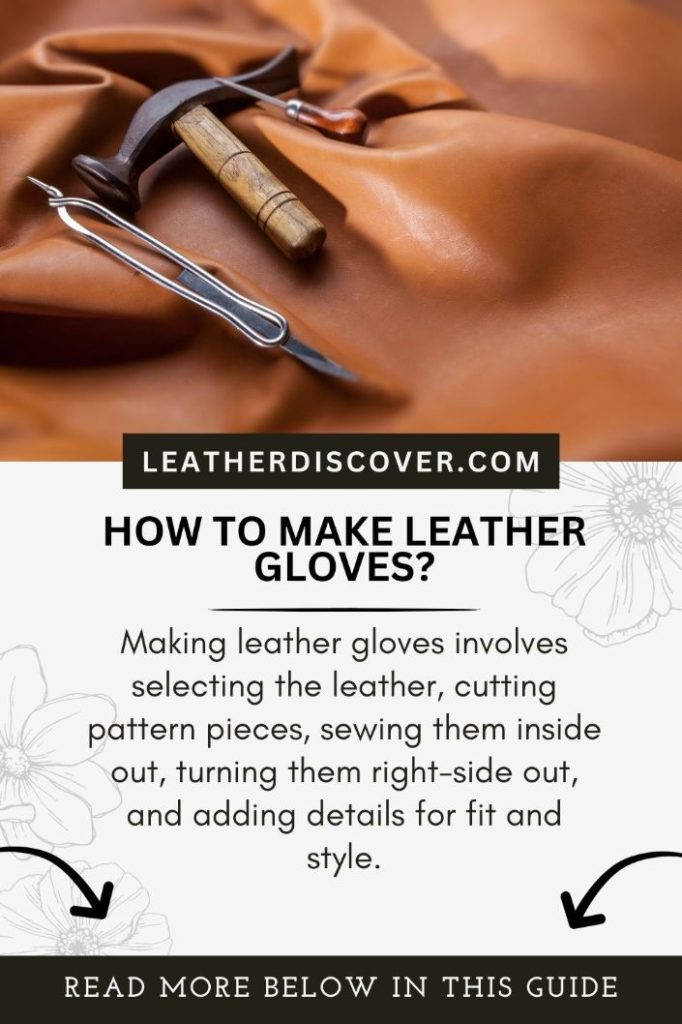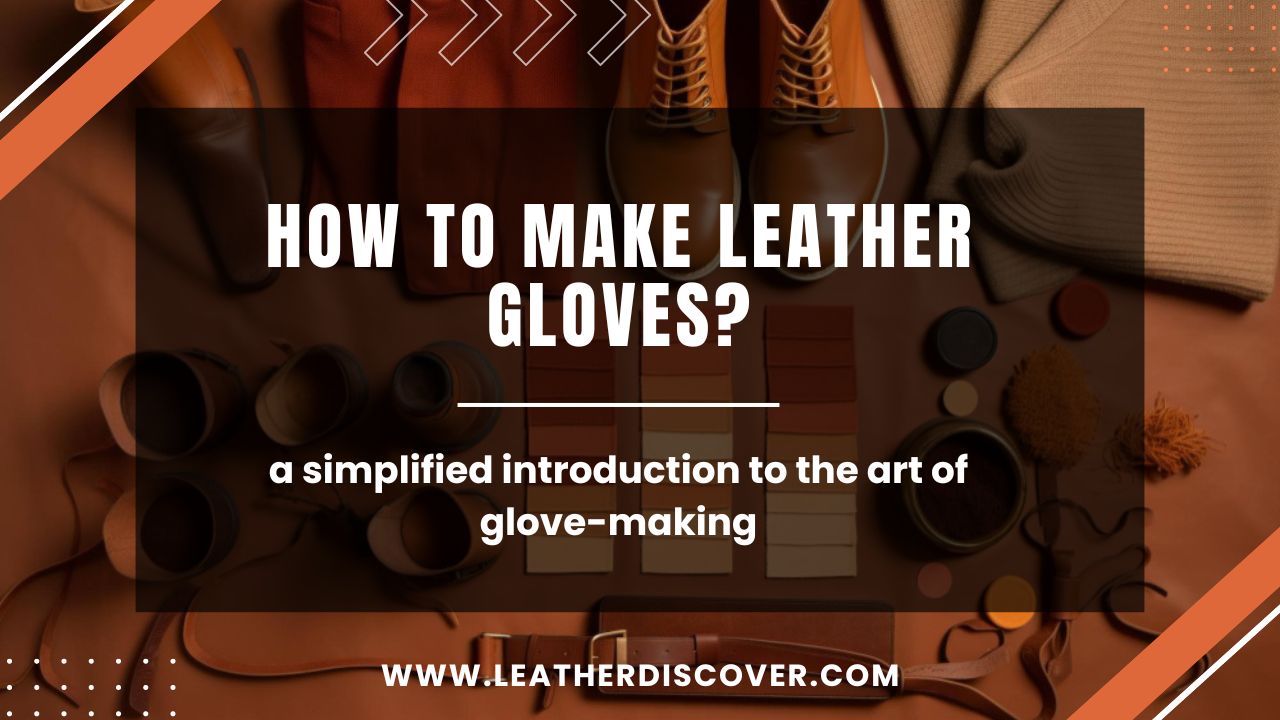Have you ever considered making your own leather gloves?
It might seem like a complex task, but with the right guidance, it’s completely doable.
Creating leather gloves is a skilled craft that has been practiced for centuries.
I remember my first attempt at crafting leather gloves. The process seemed overwhelming, but with some patience and the right materials, I ended up with a pair I was proud of.
In this article, I’ll be making you to walk you through the entire process of making leather gloves.
Also, I’ll cover everything from choosing the right leather thickness to using a size chart for a perfect fit.
By the end, you’ll have all the knowledge you need to create your own custom gloves.
So, let’s start crafting those perfect leather gloves!
Keep in mind that professional glove makers undergo extensive training, so this guide serves as a simplified introduction to the art of glove making.
[toc]

How to Make Leather Gloves?
Here’s a detailed answer to the query “How to make leather gloves?”
1. Materials You’ll Need
Before you start making leather gloves, gather the following materials:
| Material | Purpose |
|---|---|
| Leather | Main glove material, provides durability and style |
| Glove Patterns | Templates for cutting leather |
| Scissors or Rotary Cutter | Cutting leather into glove shapes |
| Sewing Machine | Stitching glove pieces together |
| Leather Sewing Needles | Specialized needles for sewing leather |
| Heavy-duty Thread | Strong thread for durable seams |
| Leather Glue | Securing seams and edges |
| Ruler and Measuring Tape | Precise measurements for glove size |
| Pins or Clips | Holding pieces together during sewing |
| Awl | Making small holes and adjustments |
| Bone Folder or Roller | Smoothing out seams and edges |
| Edge Finish or Burnishing Tools | Finishing and edging the leather |
This chart outlines the essential materials used in making leather gloves and their respective purposes in the glove-making process.
2. Making Leather Gloves:
Here are some simple 6 steps on how to make leather gloves:
Step 1: Measurement:
Creating a size chart for leather gloves requires precise measurements to ensure a proper fit.
Here’s a simple size chart template that you can use as a reference. Keep in mind that the accuracy of the measurements is crucial for making gloves that fit comfortably.
Glove Size Chart
| Glove Size | Hand Circumference (inches) | Hand Length (inches) |
|---|---|---|
| XS | 6.5 – 7.0 | 6.5 – 7.0 |
| S | 7.0 – 7.5 | 7.0 – 7.5 |
| M | 7.5 – 8.0 | 7.5 – 8.0 |
| L | 8.0 – 8.5 | 8.0 – 8.5 |
| XL | 8.5 – 9.0 | 8.5 – 9.0 |
Tips for Using the Size Chart:
When it comes to choosing the right size for leather gloves, a few steps can make all the difference.
Start by measuring the circumference of your dominant hand just below the knuckles, excluding your thumb.
I’ve found using a flexible measuring tape really helps get an accurate fit.
Next, measure from the tip of your middle finger down to the base of your hand where it meets your wrist.
This measurement ensures the glove length is just right. Remember, it’s usually best to measure your dominant hand as it tends to be slightly larger. If your measurements fall between two sizes, I’ve learned it’s better to go for the larger size for a more comfortable fit.
Keep in mind, though, glove sizing can vary between brands, so it’s wise to check their specific sizing guidelines for the perfect fit every time.
These steps have helped me find gloves that feel great and perform well, whether for work or just staying warm in colder weather.
Step 2: Create a Pattern
Use these measurements to create a paper or cardboard pattern for your gloves. Ensure it accounts for the specific style you want, whether it’s driving gloves, winter gloves, or fashion gloves.
Step 3: Cut the Leather
Step 4: Stitch the Glove Pieces
Step 5: Assemble the Gloves
Step 6: Finish the Gloves
After turning your leather gloves right side out and adjusting the fit, the next step is to fold over the cuffs and glue them to create a neat, finished edge. For added durability, you can also stitch the cuffs securely.
Once the cuffs are in place, use an edge finish or burnishing tools to smooth and polish the edges of the gloves. This enhances the overall look and durability of the leather.
Finally, apply a leather conditioner to keep the gloves supple and maintain their appearance over time. Conditioning helps protect the leather from drying out and ensures your handmade gloves remain comfortable and long-lasting.
Some Other Relevant Concerns You Might Have about Making Leather Gloves:
Let’s discuss some common and important concerns that you might need to cover and learn. It truly will help.
What Is the Best Thickness of Leather for Gloves?
The best thickness of leather for gloves depends on their intended use.
For general-purpose gloves, a medium-weight leather of around 1.0 to 1.2 millimeters (approximately 2.5 to 3 ounces) is common.
Thicker leather may be suitable for heavy-duty work gloves. While thinner leather is used for dress or fashion gloves.
How Do You Make Faux Leather Gloves?
Making faux leather gloves involves using synthetic materials like polyurethane (PU) or PVC fabric that mimic the look and feel of real leather.
The process is similar to making real leather gloves, but you use synthetic materials instead.
How Do You Make Fingerless Leather Gloves?
To make fingerless leather gloves, you’ll need a pattern, leather material, sewing machine, and basic sewing skills.
Cut the leather according to the pattern, sew the seams, and leave the fingertips open to create the fingerless style.
Why Are Leather Gloves So Expensive?
Leather gloves can be expensive due to several factors, including the quality of the leather used (premium, full-grain leather is costly), skilled craftsmanship, and brand reputation.
Additionally, the lining and design details can impact the price.
How Do You Shape Leather Gloves?
Leather gloves can be shaped by wearing them regularly.
Over time, the gloves will conform to the shape of your hand. To speed up the shaping process, you can use a glove mallet or ball to gently shape and stretch the fingers and palm to your preference.
Should Leather Gloves Be Tight or Loose?
Leather gloves should fit snugly but not be overly tight. A good-fitting leather glove will have a little room in the fingertips while hugging the palm and fingers comfortably.
They may feel slightly tight at first but should stretch and mold to your hand with wear.
How Long Do Leather Gloves Last?
The lifespan of leather gloves depends on various factors, including the quality of the leather, how frequently they are worn, and how well they are maintained.
High-quality leather gloves can last for several years or even decades with proper care and maintenance.
Should I Oil My Leather Gloves?
It’s a good idea to occasionally apply leather conditioner or glove oil to your leather gloves. This helps keep the leather supple and prevents it from drying out or becoming stiff.
Follow the manufacturer’s recommendations for how often to condition your specific gloves.
What Is the Strongest Material for Gloves?
When it comes to gloves for specific purposes, the strongest material can vary.
For example, Kevlar and other aramid fibers are incredibly strong and are often used in cut-resistant gloves. In general, leather is renowned for its strength, durability, and versatility, making it a popular choice for various types of gloves.
The choice of glove material depends on the intended use, whether it’s for protection, warmth, or style. Each material has its unique strengths and properties suited to different glove applications.
Conclusion:
So, now you know the answer to questions such as: how to make leather gloves, how do you make fingerless leather gloves, how do you make faux leather gloves, and more!
The art of making leather gloves is a craft that marries tradition and precision.
While this article provided a simplified overview of the process, it is essential to understand that creating high-quality leather gloves requires dedication, practice, and expertise. Whether for fashion, function, or personal satisfaction, crafting leather gloves offers an opportunity to explore creativity, refine skills, and appreciate the timeless appeal of this accessory.
- What Is Caiman Leather? A Detailed Guide - July 25, 2024
- What Is Tumbled Leather?A Complete Guide - July 25, 2024
- What Is Kip Leather? Premium Leather Choice - July 24, 2024

